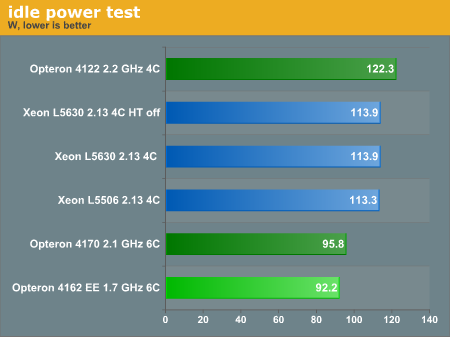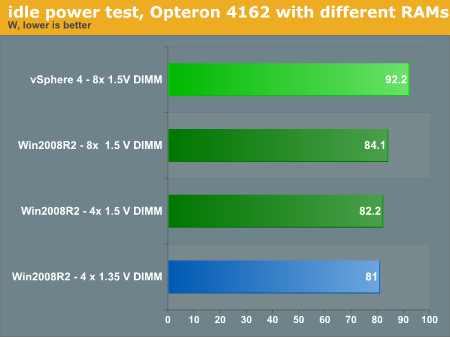Balancing Power, Price, and Performance in the Server CPU World
by Johan De Gelas on March 3, 2011 7:07 PM EST- Posted in
- IT Computing
- AMD
- Intel
- 1000W
- Xeon
- Opteron
- Cloud Computing
Idle Power Use
According to AMD, the key market for the low power "Lisbon" Opteron EE and HE is the cloud and web hosting space, where achieving the lowest power consumption possible is priority number one. So we measured the idle power draw running vSphere 4.1. The power policy selected was "Balanced".

Before we start analyzing the numbers, we must say that the Intel platform can probably go lower. It is possible to use a 450W PSU in this server, but we only had the 650W version available. This is an 80 Plus Silver certified PSU, so it should be at least 75% efficient at 10% load and 85% efficient at 20% load, and we're at around 15% load for this test. Although the idle numbers might be somewhat high for the Intel platform, our real-world power numbers on the next page shouldn't be off by more than a few watts, and those real-world numbers are the ones that count.
The AMD system came equipped with 16GB of low power DIMMs, but we did not use them for this test. The reason is that our vApusMark II takes 14GB per tile, and our standard test for dual socket systems is to use two tiles. Those two tiles need at least 28GB of RAM, plus some space for the ESX console and hypervisor (0.3 to 0.8 G RAM for the console + 0.5GB to 1GB for the vmkernel). We can show you what effect these low power DIMMs have at idle:

Even at idle, a hypervisor has more work to do than a supervisor OS like Windows 2008 R2. The result is a 10% higher power draw at idle. Each regular 1.5V DDR3 DIMM seems to take 0.5W at idle (2 Watt/4). If you replace four regular DDR3 DIMMs with four low power DIMMs at 1.35V, you can cut the RAM power draw in half. Low power DIMMs seem to save 0.3W per DIMM (1.2W / 4) at idle. So all in all, the RAM subsystems seems to draw little power at idle.
When the SQL server 2008 was running at 90% CPU load we measured a difference of 4.9W between four low power and 1.5V DDR-3 DIMMs. So low power DIMMs save you about 1.25W per 4 GB DIMM.










35 Comments
View All Comments
pvdw - Thursday, March 10, 2011 - link
Don't worry duploxxx, no company in their right mind would hire him. And those who do, deserve what they get for just hiring a zealot with little to no expertise.pvdw - Thursday, March 10, 2011 - link
He's just a mindless troll, let's ignore him.theangryintern - Friday, March 11, 2011 - link
This is a bit OT, did I miss the full article about AnandTech's server upgrade, or has the story not been posted yet? I remember we got a couple preview articles, and now nothing for several months. I was really interested in seeing the full story of the upgrades.gujiong2002 - Tuesday, April 5, 2011 - link
Typo?meorah - Wednesday, April 20, 2011 - link
Its too bad the benchmarks didn't include comparisons to a mainstream processor like the E5620. That way we could get a sense of scale between all the low power processor performance/power usage levels.In other words, if the E5620 is only slightly worse than the low power processors, it makes the scale smaller so the differences between the low power processors are more pronounced, similar to the charts in the article.
However, if the E5620 is much worse than the low power procs, it makes the chart scale much higher and suddenly the relative difference between the low power procs seems almost insignificant.
I understand the concept of max density and therefore max performance/watt for datacenters, but there are plenty of small businesses with 1-4 racks in a corporate site computer closet running back-office systems who are also interested in balancing TCO on a smaller scale, and including a mainstream proc in your charts would help them (me). :)